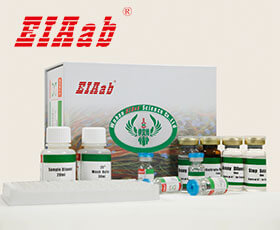Zfp36l1 (基因名), mRNA decay activator protein ZFP36L1 (蛋白名), tisb_rat.
产品名称:
Rat Zfp36l1/ mRNA decay activator protein ZFP36L1 ELISA Kit
mRNA衰变激活蛋白ZFP36L1
货号:
E5957r
商标:
EIAab®
监管等级:
别名:
Butyrate response factor 1, EGF-inducible protein CMG1, TPA-induced sequence 11b, Zinc finger protein 36, C3H1 type-like 1, ZFP36-like 1, Brf1, Cmg1, Tis11b
检测方法:
ELISA
特异性:
Natural and recombinant rat mRNA decay activator protein ZFP36L1
样品类型:
Serum, plasma, tissue homogenates, cell culture supernates and other biological fluids
样品数据:
登录.
研究领域:
Epigenetics
通用注释
亚单元:
Associates with the cytoplasmic CCR4-NOT deadenylase and RNA exosome complexes to trigger ARE-containing mRNA deadenylation and decay processes. Interacts with CNOT1. Interacts (via N-terminus) with CNOT6. Interacts with CNOT7; this interaction is inhibited in response to phorbol 12-myristate 13-acetate (PMA) treatment in a p38 MAPK-dependent manner. Interacts with DCP1A. Interacts (via N-terminus) with DCP2. Interacts (via N-terminus) with EXOSC2. Interacts with XRN1. Interacts (via phosphorylated form) with YWHAB; this interaction occurs in a protein kinase AKT1-dependent manner. Interacts (via phosphorylated form) with YWHAZ; this interaction occurs in a p38 MAPK- and AKT-signaling pathways.
功能:
Zinc-finger RNA-binding protein that destabilizes several cytoplasmic AU-rich element (ARE)-containing mRNA transcripts by promoting their poly(A) tail removal or deadenylation, and hence provide a mechanism for attenuating protein synthesis (PubMed:10751406, PubMed:12748283). Acts as a 3'-untranslated region (UTR) ARE mRNA-binding adapter protein to communicate signaling events to the mRNA decay machinery (PubMed:12748283). Functions by recruiting the CCR4-NOT deadenylase complex and components of the cytoplasmic RNA decay machinery to the bound ARE-containing mRNAs, and hence promotes ARE-mediated mRNA deadenylation and decay processes (PubMed:12748283). Induces also the degradation of ARE-containing mRNAs even in absence of poly(A) tail (PubMed:11279239). Binds to 3'-UTR ARE of numerous mRNAs (PubMed:10751406). Positively regulates early adipogenesis by promoting ARE-mediated mRNA decay of immediate early genes (IEGs). Promotes ARE-mediated mRNA decay of mineralocorticoid receptor NR3C2 mRNA in response to hypertonic stress. Negatively regulates hematopoietic/erythroid cell differentiation by promoting ARE-mediated mRNA decay of the transcription factor STAT5B mRNA. Positively regulates monocyte/macrophage cell differentiation by promoting ARE-mediated mRNA decay of the cyclin-dependent kinase CDK6 mRNA. Promotes degradation of ARE-containing pluripotency-associated mRNAs in embryonic stem cells (ESCs), such as NANOG, through a fibroblast growth factor (FGF)-induced MAPK-dependent signaling pathway, and hence attenuates ESC self-renewal and positively regulates mesendoderm differentiation. May play a role in mediating pro-apoptotic effects in malignant B-cells by promoting ARE-mediated mRNA decay of BCL2 mRNA. In association with ZFP36L2 maintains quiescence on developing B lymphocytes by promoting ARE-mediated decay of several mRNAs encoding cell cycle regulators that help B cells progress through the cell cycle, and hence ensuring accurate variable-diversity-joining (VDJ) recombination and functional immune cell formation. Together with ZFP36L2 is also necessary for thymocyte development and prevention of T-cell acute lymphoblastic leukemia (T-ALL) transformation by promoting ARE-mediated mRNA decay of the oncogenic transcription factor NOTCH1 mRNA. Participates in the delivery of target ARE-mRNAs to processing bodies (PBs). In addition to its cytosolic mRNA-decay function, plays a role in the regulation of nuclear mRNA 3'-end processing; modulates mRNA 3'-end maturation efficiency of the DLL4 mRNA through binding with an ARE embedded in a weak noncanonical polyadenylation (poly(A)) signal in endothelial cells. Also involved in the regulation of stress granule (SG) and P-body (PB) formation and fusion. Plays a role in vasculogenesis and endocardial development. Plays a role in the regulation of keratinocyte proliferation, differentiation and apoptosis. Plays a role in myoblast cell differentiation.
亚细胞位置:
Nucleus
Cytoplasm
Cytoplasmic granule
Cytoplasm
P-body
Shuttles between the nucleus and the cytoplasm in a XPO1/CRM1-dependent manner. Component of cytoplasmic stress granules. Localizes in processing bodies (PBs).
该产品尚未在任何出版物中被引用。
[1].
大鼠mRNA衰变激活蛋白ZFP36L1(Zfp36l1)ELISA试剂盒可以做多少个样本?
大鼠mRNA衰变激活蛋白ZFP36L1(Zfp36l1)ELISA试剂盒分为2种规格,96孔和48孔。96孔的试剂盒,标曲和样本都做复孔的话,可以检测40个样本。96孔的试剂盒,标曲和样本都不做复孔的话,可以检测88个样本。
[2].
大鼠mRNA衰变激活蛋白ZFP36L1(Zfp36l1)ELISA试剂盒使用视频?
大鼠mRNA衰变激活蛋白ZFP36L1(Zfp36l1)ELISA试剂盒实验操作视频在以下网址中,对每一步的实验步骤都做了演示,方便实验员能更好地理解ELISA实验的过程。
https://www.eiaab.com.cn/lesson-tech/805.html
https://www.eiaab.com.cn/lesson-tech/805.html
[3].
大鼠mRNA衰变激活蛋白ZFP36L1(Zfp36l1)ELISA试剂盒是放在-20℃冰箱保存吗?
EIAab的大鼠mRNA衰变激活蛋白ZFP36L1(Zfp36l1)ELISA试剂盒,洗涤液、底物、终止液保存于4℃,其余试剂-20℃冰箱保存。
[4].
大鼠mRNA衰变激活蛋白ZFP36L1(Zfp36l1)ELISA试剂盒原理?
双抗体夹心法:用纯化的抗体包被微孔板,制成固相抗体,往包被有固相抗体的微孔中依次加入标准品或受检样本、生物素化抗体、HRP标记的亲和素,经过彻底洗涤后用底物TMB显色。用酶标仪在450nm波长下测定吸光度(OD值),计算样本浓度。
竞争法:用纯化的抗体包被微孔板,制成固相抗体,往包被有固相抗体的微孔中依次加入标准品或受检样本和生物素标记的目标分析物,受检标本中抗原与生物素标记抗原竞争结合有限的抗体。再加入HRP标记的亲和素,经过彻底洗涤后用底物TMB显色。用酶标仪在450nm波长下测定吸光度(OD值),计算样本浓度。
竞争法:用纯化的抗体包被微孔板,制成固相抗体,往包被有固相抗体的微孔中依次加入标准品或受检样本和生物素标记的目标分析物,受检标本中抗原与生物素标记抗原竞争结合有限的抗体。再加入HRP标记的亲和素,经过彻底洗涤后用底物TMB显色。用酶标仪在450nm波长下测定吸光度(OD值),计算样本浓度。
[5].
大鼠mRNA衰变激活蛋白ZFP36L1(Zfp36l1)ELISA试剂盒中需要使用的样品量是多少?
夹心法100μL/孔,竞争法50μL/孔。如样本浓度过高时,应对样本进行稀释,以使稀释后的样本符合试剂盒的检测范围,计算时再乘以相应的稀释倍数。
[6].
如何分析大鼠mRNA衰变激活蛋白ZFP36L1(Zfp36l1)ELISA试剂盒数据?
建议标准曲线,并计算样本浓度。对于elisa的曲线拟合,一般建议采用4参数曲线拟合,4参数曲线拟合通常更适合免疫分析。推荐使用专业软件进行曲线拟合,例如curve expert 1.3。根据样本的OD值由标曲查出相应的浓度,再乘以稀释倍数;或用标准物的浓度与OD值计算出标曲的回归方程式,将样本的OD值代入方程式,计算出样本浓度,再乘以稀释倍数,即为样本的实际浓度。以下链接是curve expert 1.3软件拟合曲线的方法。
https://www.eiaab.com.cn/news/502/
https://www.eiaab.com.cn/news/502/
[7].
大鼠mRNA衰变激活蛋白ZFP36L1(Zfp36l1)ELISA试剂盒中是否包含人和动物的副产物,是否包含感染的或者传染性原料如HIV等?
除了抗体和稀释液中的BSA,不含其它人和动物的副产物,也不含感染材料。
[8].
收集大鼠mRNA衰变激活蛋白ZFP36L1(Zfp36l1)ELISA试剂盒血浆样本,用什么作为抗凝剂?
一般建议用EDTA和肝素作为抗凝剂。
[9].
大鼠mRNA衰变激活蛋白ZFP36L1(Zfp36l1)ELISA试剂盒酶标板可以拆成几部分?拆的时候是否需要避光,无菌?
大鼠mRNA衰变激活蛋白ZFP36L1(Zfp36l1)ELISA试剂盒酶标板是8×12孔条,可拆卸,板子可以拆成12条,注意避免孔污染,不需要避光和无菌。暂时不用的板子,放回原来装的袋子里,密封保存。
[10].
大鼠mRNA衰变激活蛋白ZFP36L1(Zfp36l1)ELISA试剂盒样本如何保存?
尽量检测新鲜样本。若无新鲜样本,则4℃保存1周,-20℃保存1个月,-80℃保存2个月。
反馈墙
评论数 : 0
所有用户
所有用户
默认排序
默认排序
最近
早期
目前还没有评论。






通知
规格
数量
单价 (¥)
小计 1 (¥)
小计 2:
¥

规格
数量
单价 (¥)




 验证序列:
验证序列:




 折扣:
折扣: